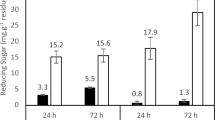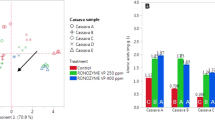Abstract
AN earlier communication1 reported the resolution of a maceration factor from endopolygalacturonase (PG) in culture filtrates of Sclerotinia fructigena Aderh. and Ruhl., by means of gel filtration on dextran Sephadex ‘G 75’ and chromatography on ‘Ecteola’-cellulose. The biochemical basis of maceration of potato slices by these preparations was not elucidated, but McClendon2 has demonstrated that, in chromatography on cellulose phosphate of an ultra-filtered and freeze-dried sample of our culture filtrate, maceration of potato disks occurred in two peaks, one associated with a major PG peak and the other with a minor PG peak, with indications that arabanase or galactanase may macerate. We have shown independently that arabinose is liberated from potato fibre by a purified ‘maceration factor’ preparation free of PG and, subsequent to McClendon's findings, from lupin seed pectate. Incubation of the purified preparation with potato fibre was also accompanied by a release of soluble uronide, as determined by the carbazole method3 (Fig. 1); the uronide was shown to be of high molecular weight by its failure to pass through a ‘Visking’ dialysis membrane, suggesting that a partial breakdown of in soluble ‘protopectin’ had occurred.
This is a preview of subscription content, access via your institution
Access options
Subscribe to this journal
Receive 51 print issues and online access
$199.00 per year
only $3.90 per issue
Buy this article
- Purchase on Springer Link
- Instant access to full article PDF
Prices may be subject to local taxes which are calculated during checkout
Similar content being viewed by others
References
Byrde, R. J. W., and Fielding, A. H., Nature, 196, 1227 (1962).
McClendon, J. H., Amer. J. Bot., 51, 628 (1964).
McComb, E. A., and McCready, R. M., Analyt. Chem., 24, 1630 (1952).
Joslyn, M. A., Adv. Food Res., 11, 1 (1962).
Hirst, E. L., and Jones, J. K. N., J. Chem. Soc., 1221 (1947).
Hirst, E. L., Jones, J. K. N., and Walder, W. O., J. Chem. Soc., 1225 (1947).
Börjeson, H., Jerkeman, P., and Lindberg, B., Acta Chem. Scand., 17, 1705 (1963).
Lederberg, J., J. Bact., 60, 381 (1950).
Snyder, J. A., and Link, K. P., J. Amer. Chem. Soc., 74, 1883 (1952).
Jerkeman, P., and Lindberg, B., Acta Chem. Scand., 17, 1709 (1963).
Folin, O., and Denis, W., J. Biol. Chem., 12, 239 (1912).
Brown, W., Ann. Bot., 29, 313 (1915).
Cole, M., and Wood, R. K. S., Ann. Bot. N.S., 25, 435 (1961).
Bateman, D. F., Phytopathology, 53, 1178 (1963).
de Bary, A., Bot. Ztg., 44, 409 (1886).
Author information
Authors and Affiliations
Rights and permissions
About this article
Cite this article
BYRDE, R., FIELDING, A. An Extracellular α-L-Arabinofuranosidase secreted by Sclerotinia fructigena. Nature 205, 390–391 (1965). https://doi.org/10.1038/205390b0
Published:
Issue Date:
DOI: https://doi.org/10.1038/205390b0
This article is cited by
-
Tissue maceration during pathogenesis ofFusarium oxysporum andF.moniliforme
Folia Microbiologica (1984)
-
The enzymatic maceration of plant tissue
Netherlands Journal of Plant Pathology (1968)
-
Cell Wall Degradation by a Pectate Transeliminase
Nature (1967)
Comments
By submitting a comment you agree to abide by our Terms and Community Guidelines. If you find something abusive or that does not comply with our terms or guidelines please flag it as inappropriate.



